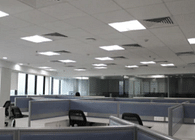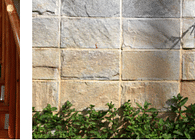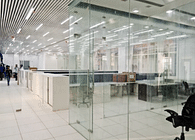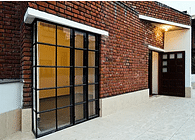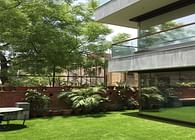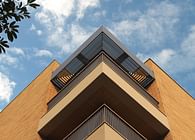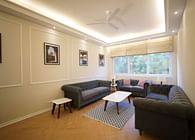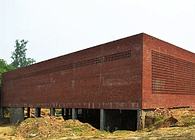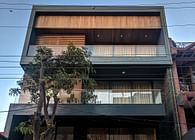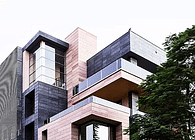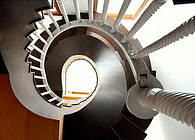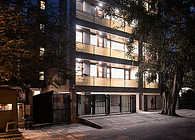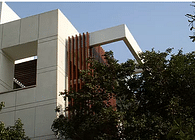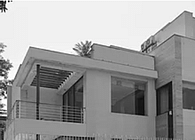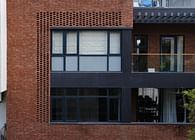
Vasant Vihar began life in post-independence Delhi as a sleepy suburb to the administrative capital. Occupied largely by senior government functionaries, it held on to its status of a quiet enclave of detached houses for decades, before slowly being consumed by the city’s relentless expansion.
This urban growth has affected the locality both in spirit and in form. Single family homes have been replaced with six storey apartment buildings, with the subterranean level largely being used as offices for practicing professionals. Parking on the ground level sits below 4 storeys of apartments, and larger plots of land often have multiple apartments per floor.
Largely developed by private financiers, the emerging landscape has little coherence in architectural intent. Trends change every five to seven years and design intents are abandoned with the same pace as they were adopted. On a typical street, one might find a 15 year old classical design next to a 10 year old contemporary design and a 2 year old Palladian Villa.
Within this landscape of conflicting context, lay an ageing building on a site of 350 Sq.Mts. The owners wanted to rebuild to elicit maximum benefit of the area offered by new regulations. This would not only allow the owners more space, but also to reaffirm the status of the property as a family home for the next generation.
Six apartments were planned, laid over 4 floors. Additionally, four workspace were created in the basement, along with dedicated car parking for eight cars. The building was designed to provide common amenities, but complete privacy to the occupants from one another. To achieve this, a common entrance lobby on the ground floor provides access from multiple access points to the main stair and elevator.
On the first two of the upper floors, the building is divided into two apartments, each with a living room, kitchen and two bedrooms, with en suite bathrooms. These four apartments enjoy the full frontage of the plot, a generous 41’, at each end. The full width of the building ensures that even though each of these apartments only occupies half a floor, each of the rooms receives sunlight and adequate ventilation through full sized windows. These windows open into a five foot wide continuous wood-lined veranda, designed to maintain complete privacy from surrounding neighbors.
The top two floors have a single apartment each, occupying the complete 2200SF plate. The living room of these apartments span the full width of the building and is approached from a wood lined foyer, with a classical marble floor pattern. The living room also opens seamlessly to the front veranda for expanding the entertainment space. Each of these apartments is lavishly appointed with three large bedrooms with en suite bathrooms and their own private rear veranda. There is a centrally positioned kitchen, connected through a utility balcony to a staff room, with its own bathroom.
The facade of the building is an exercise in restraint. No attempt has been made to follow the latest trends of the neighborhood. Rather, the intent was to design a subtle addition to the neighborhood, an act of maturity that looks forward to the next few decades of ownership and maintenance rather than trying to impress the neighbors with architectural virtuosity.
The end walls have been finished in a pale cream colored brick, chosen for its bright and robust nature. The slim horizontal bands on each floor are finished in exposed grit wash, a hardy surface texture that allows white chips to reflect light and avoid absorption into the structural slab. Dense, vertically oriented railings provide the requisite safety for the deep verandas, and the building is capped with a band of exterior grade wood, designed to weather and turn to a light shade to complement the brick.
The project illustrates an evolving understanding about the durability of materials in our harsh climate. Brick is inherently durable - Clay bricks last almost indefinitely, being largely immune to fire, wind borne debris, and temperature fluctuations and their exceptional thermal mass helps mitigate heat transfer. On a TCO and life cycle basis, bricks outperform almost every other building material, effectively reducing the environmental impact from other systems like air conditioning and heating.
Every component of the building was selected with the same parameters of high performance, inherent robustness and energy efficiency. Aluminium windows with double glazing are used all around, the terrace is insulated with PU sheets overlaid with Kota stone, and LED lighting is used throughout the building. Sensors are fitted in the washrooms, and they automatically control the lights based on movement and ambient light conditions. The apartments are secured with a key less central security system with digital access.
The building then, is a nod to the subtly, elegant homes of the locality that have been slowly replaced with all manner of oddities. It re imagines the contemporary apartment building not as an opportunity to stretch the boundaries of architectural possibility, but to hone the facade to the key essentials of sustainability.
Status: Built
Location: New Delhi, IN
My Role: Architecture

